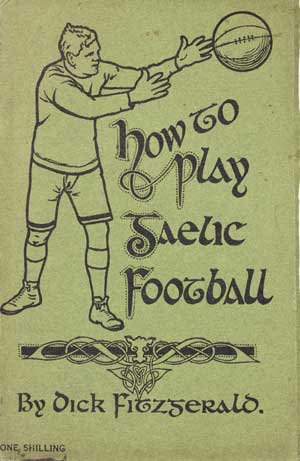How to Play Gaelic Football (1914)
Published in Artefacts, Issue 5 (September/October 2022), Volume 30By Siobhán Doyle

Above: How to Play Gaelic Football (1914) by Dick Fitzgerald, the only published book on GAA coaching until 1958. (NMI)
In 1914, a book entitled How to play Gaelic football was published and is widely regarded as the first illustrated coaching manual for Gaelic Games. Printed by Guy & Co. of Cork and retailing at one shilling, the contents include an introductory chapter, sections on the duties of the various positions on the field, an outline of the role of the team captain and referee, as well as guidelines on applying football methods to hurling and playing with thirteen players a side.
The book was written by Dick Fitzgerald (1886-1930), holder of five All-Ireland medals with the Kerry footballers and an exceptionally talented player. Although Fitzgerald can lay claim to the title of Gaelic football’s first superstar and was described at the time as ‘one of the most resourceful, scientific and deadly accurate forwards of all time’, he tends not to feature in Teams of the Millennium or greatest footballer conversations, possibly owing to the non-existence of film footage of his prowess. Fitzgerald was well positioned to write this seminal instruction manual not only because of his skills on the field of play but also because he served as an inter-county coach and referee, in addition to various administrative roles on club and county committees. The book was written while Fitzgerald was still playing as Kerry captain and remained the only published book on GAA coaching until 1958, when his fellow Dr Crokes clubman Eamonn O’Sullivan published The Art and Science of Gaelic Football.
Fitzgerald’s football career was disrupted by his involvement in the Irish revolution. In 1916, he was interned at Frongoch prison camp in Wales. There, he helped organise football tournaments, which were an important part of maintaining morale and providing entertainment, exercise and routine amongst the internees. Fitzgerald played in a match that eventually became known as the ‘All-Ireland final behind barbed wire’ in 1916, which took place in a field surrounded by barbed wire that the internees had renamed Croke Park. Séamas Ó Maoileoin wrote first-hand accounts of Gaelic football matches between internees in the camp and was ‘convinced that he [Fitzgerald] was better in Frongoch than he ever was at Croke Park’.
Dick Fitzgerald died on Friday 26 September 1930 after falling from a roof in Killarney. It was All-Ireland final weekend and Kerry were due to play Monaghan in Croke Park. The Kerry county board requested that relatives consider postponing the funeral as many Kerry players and supporters were already making their way to Dublin. And so, Fitzgerald was buried in Killarney the day after Kerry captured their ninth All-Ireland football title by beating Monaghan comprehensively on a score line of 3-11 to 0-2. The match was preceded by the playing of Chopin’s ‘Funeral march’ by the Artane Boys’ Band, demonstrating the esteem with which Fitzgerald was regarded in GAA circles. His legacy lives on in the rich traditions of Kerry football not only through this book, but also with the county’s home venue in Killarney named Fitzgerald Stadium in his honour.
This book will feature in Siobhán Doyle’s forthcoming A History of the GAA in 100 Objects (Merrion Press, October 2022).
















